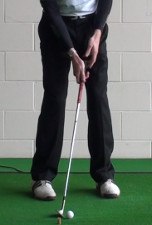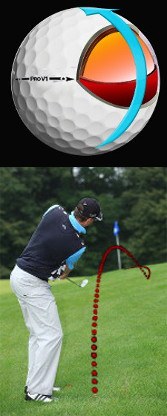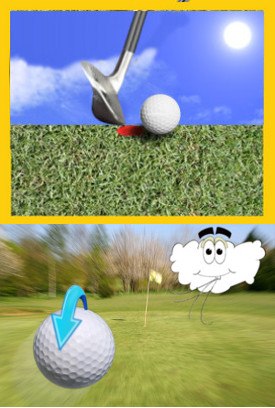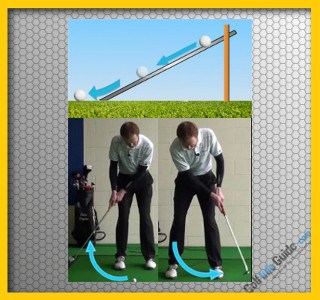
Besides wind, the firmness of a course's greens might be the most important variable in a given round of golf. Even the pros struggle to handle rock-hard greens.
Many amateurs frown when faced with extra-firm surfaces. They get discouraged when an approach shot doesn't hold, or a chip takes a hard bounce and blows past the flag. Unless they make the necessary adjustments – both physical and mental – they're in for a long day.
It's especially frustrating to hit a solid wedge shot, only to watch it skid and release over the green. You need two ingredients to combat these conditions – more height and more spin. Here's how to get them:
- Take less club and swing harder: Let's say you've got a yardage that puts you between an easy pitching wedge and a full sand wedge. The easy pitching wedge will fly lower, spin less and roll more after landing. Take a full swing with the sand wedge and you'll hit the ball higher with extra spin, stopping it quickly.
- Move the ball back in your stance: If you address wedge shots with the ball forward of center (closer to your left foot), move it back to the middle of your stance. This will create a steeper angle of approach and extra spin. Be careful not to move the ball too far right as you'll de-loft the club and hit the shot too low.
- Switch to a higher-spin ball: Depending on the ball you normally play, you might get more spin from a different model. Your best bet for firm greens is a so-called “tour” ball – those played by pros and better amateurs. (Examples include the Titleist ProV1, Bridgestone Tour B330 and Callaway HEX Black.) They're a little more expensive, but they'll cost you little if any distance off the tee while saving you strokes inside 100 yards.
Above all, playing hard greens calls for patience and accepting whatever they dish out. Control the factors that are in your hands – spin and trajectory – and take whatever comes your way.

How to Hit Wedges into Firm Greens
Generally speaking, playing golf on soft greens is easier than playing on firm greens. When you play on soft greens, the ball will usually stop close to where it lands – giving you plenty of control over the positioning of your shots, and taking many of the dangers of the course out of play. For instance, a shot that lands near the edge of a firm green may bounce into the bunker, while a ball that lands on a soft green will stop quickly and leave you with a birdie putt. There are some drawbacks to playing on soft conditions, such as decreased distance on your drives, but the advantage of playing into soft greens cannot be overlooked.
In this article, we are going to talk specifically about one of the challenges that comes along with playing on firm greens – hitting accurate wedge shots. Any time you have a wedge in your hands for an approach shot, your mind automatically thinks about sticking the ball close and making a birdie. Wedges are often called 'scoring clubs' for a reason, as they give you a great chance to post a good score for the hole. However, if you are playing a wedge into a firm green, you might have to rethink your aggressive ways. Sure, you can still hit great wedge shots to firm greens, but you have to be careful as you will have very little margin for error in most cases.
There are a number of elements in play with regard to how you are going to play your wedges into firm greens. First, there is the matter of making clean contact in order to put a high rate of spin on the ball. Spin is one of the things that will help you stop your shots quickly on firm surfaces, so you want to make sure you are getting plenty of spin when you strike your wedges. Also, there is an element of strategy that comes into play when dealing with firm greens, so you will need to pay attention to your course management in order to stay out of trouble. Finally, firm greens often mean fast greens in terms of putting, so considering how to set yourself up for a reasonable putt is another piece of this puzzle. All of these topics are going to be covered in the content below.
Depending on where you live, you may or may not get the chance to play golf on firm greens regularly. Courses located in damp and cool climates are soft throughout much of the year, meaning you may not see firm greens often if that describes your home area. However, courses in the desert or other dry and warm locations will usually be firm, so players in those locations need to understand how to attack firm greens properly if they are going to succeed out on the course. No matter where you live, however, you should at least be familiar with this concept so you are ready when firm conditions do arrive.
All of the content below is based on a right handed golfer. If you happen to play left handed, please take a moment to reverse the instructions as necessary.

What to Expect
One of the things that most good golfers do prior to hitting any shot is to visualize how the shot is going to play out in front of them. They will stand behind the ball and 'see' the shot from start to finish – including its flight, bounce, and roll. When you are able to visualize your shots in great detail, you will stand a better chance of actually executing them successfully.
With that in mind, it is helpful to know what to expect when you are playing a wedge shot into a firm green. How is the ball going to respond? If you aren't familiar with how the ball will react, there will be almost no way to accurately picture the shot at hand. So, with that in mind, let's look at some of the key points to expect when hitting a wedge shot into a firm green.
- A big bounce. This is a point that should probably go without saying. When the greens are firm, you are going to get a big first bounce on nearly all of your shots. The spin that you place on the ball isn't going to really take much effect until at least the second bounce, so the first bounce will usually be pretty significant. If the ball comes in shallow (low), the bounce will stay low to the ground while jumping forward a good distance. On the other hand, a shot that comes in high will probably bounce pretty high back up in the air, while not traveling as far forward. Knowing that the ball is going to take a significant bounce, you will need to pick out an intelligent target that gives you the room you need to bring the ball to a stop.
- Spin to a stop. When you strike the ball cleanly, you should have plenty of spin on your ball as it lands – meaning the ball should stop quickly after the second or third bounce. As mentioned above, your spin rate isn't going to do much to the first bounce, but the second bounce should be rather small and the ball should stop quickly at this point. Remember, the ball isn't likely to spin backwards as it might on a soft green, so you shouldn't be playing for any kind of reverse movement. The typical well-struck wedge shot into a firm green is going to take a couple of bounces before stopping in its tracks.
- Slopes matter. The slope of the green doesn't make much difference when you are playing a shot into a soft green – the ball is going to stop quickly regardless. However, slope becomes a big factor when the greens are firm. If you are playing into a green that is sloped back to front, your first bounce will not be as big and the ball will stop relatively quickly. Of course, when playing to a green that is sloping away, the ball will take a big bounce and your spin might not have as much stopping power. When planning your shot, be sure to take into account the slope of the ground around the hole.
The best way to get comfortable with how the ball will respond on firm greens is through experience, but the points above should get you started in the right direction. Once you have a good understanding of what to expect out of your wedge shots after they land, you can then turn your attention to crafting a good plan and making a great swing.

Planning Your Shot
It is easy to take wedge shots for granted. After all, if the shot in front of you is 100 yards and there isn't much in between you and the hole, you may think that the best strategy is just to aim at the flag and swing away. While that might end up being the right approach, there are a few things you should think about before you take your stance and hit the shot. Wedge shots are certainly an opportunity to score, but they can go wrong as well – and turning an easy wedge shot into a bogey (or worse) is one of the fastest ways to send your round in the wrong direction.
What kind of points should you be thinking about as you plan your wedge shot into a firm green? Consider the following questions –
- Is there trouble short or long? You shouldn't have much trouble getting the ball on line with a typical wedge shot. You aren't really going to be able to hook or slice the ball to a significant degree when playing a wedge, so the main thought on your mind should be distance control. If you get the distance right, there is a good chance that you will have a relatively short putt left for your birdie. While thinking about distance, take a look at the target and decide if you would rather be short or long with your wedge shot. Obviously you would prefer control your distance perfectly, but that isn't always going to happen. If you do miss, would it be better to be long or short? For example, if there is a deep bunker sitting just in front of the green, you would obviously rather error on the long side to stay out of the trap. Or, if there is water behind the green, leaving the ball a bit short would be the safe play. Since firm greens can cause your ball to take a big bounce – potentially off of the putting surface – you need to be smart about making your mistake on the correct side in order to stay out of trouble.
- Read your lie. If you have a clean lie in the fairway, you should have nothing to worry about with regard to your wedge shot. The ball should fly up to a normal height, and it should have plenty of spin in order to stop after a bounce or two (as long as you make clean contact). The story is different from the rough, however. Playing a wedge shot from the rough into a firm green is a challenging proposition, as the ball is going to come in with very little spin – meaning it won't be able to stop after a couple of bounces as it would when played from the fairway. Hitting a wedge shot to a firm green from the rough is difficult because of how much bounce and roll you are going to have to deal with. As you plan your shot, you should anticipate this issue and use a target and line which gives the ball plenty of room to roll.
- Watch the wind. Since wedge shots can get high up into the air on the way to the hole, you need to be sure to check the wind before swinging away. Fortunately, side winds won't affect these shots too dramatically, as the short distance between yourself and the hole limits the distance that the wind can force the ball to move from side to side. However, head winds and tail winds are a much bigger factor. When playing downwind, expect a bigger bounce and a flatter ball flight overall, as the wind will knock the shot down in most cases. On the other hand, playing into the wind causes the ball to fly even higher, and the spin to be even greater when the shot lands. This is good news for stopping your ball quickly, but bad news for trying to reach the target. Shots played into the wind should usually be hit lower on purpose in order to allow them to cover the necessary distance.
Golf is such a difficult game in large part because of the countless variables that are in place on each shot that you hit. You can't just go into a wedge shot thinking about making a good swing and watching the ball fly – you have to consider things like wind, the lie of the ball, the terrain around the green, and more. Only when you take the time to think about all of these issues will you be able to consistently produce quality wedge shots on a firm golf course.

Making the Swing
The good news when it comes to hitting wedges into firm greens is this – there really isn't anything about your swing that needs to change. The same solid technique that you are (hopefully) using with your wedge swing currently will work just fine when you are hitting into hard greens. As a reminder of what it is that is important when it comes to a wedge swing, review the following points before practicing your wedge game during your next visit to the range.
- Stay centered. You shouldn't be trying to swing your wedges particularly hard, as you don't need to hit the ball a long distance on this kind of shot. So, instead of being focused on power, you want to focus on your ability to hit the ball cleanly at the bottom of the swing. To make sure you catch the ball cleanly as often as possible, it is important to remain balanced and centered over the shot. As you swing back, avoid the temptation to allow your weight to slide onto your right foot. Instead, keep your weight in the middle of your stance and use your rotation to move the club back and through.
- Eyes on the ball. This is an old golf tip to be sure, but it remains relevant to this day. If you are going to catch the ball cleanly and spin it as effectively as possible, you need to make sure that you are keeping your eyes down on the ball all the way through impact. It is fine if your head needs to move a little bit in order to accommodate the rotation of your body, but your eyes need to stay down so you can see what you are trying to hit. Many amateur golfers get into the habit of looking up early to see where the ball is heading, but that is always a mistake. Looking up early isn't going to help you keep the ball on target, so you might as well look down and trust your swing to send the ball in the correct direction.
- Aggressive through the hitting area. One of the common mistakes that is made by amateur players when hitting wedge shots is to slow down the club as it moves through impact. Since wedge shots are not shots that are centered around power, some players feel like they can just 'guide' the ball toward the hole. Of course, that is the wrong way to go about this shot. Instead, you should be swinging aggressively through impact, trying to strike the ball in the process of a full release. An aggressive strike is one of the keys to creating spin, and you are going to need plenty of spin to stop the ball on a firm green.
- Using the right gear. Okay, so this isn't a point that is related to your swing directly, but it is still important in the big picture of hitting quality shots to firm greens. In order to get the maximum amount of spin on these shots, you need to be using the right golf ball and you need a wedge with clean, relatively fresh grooves. The right ball is one that works for your game and your swing, providing a healthy spin rate while also giving you feel and control around the rest of the course. When it comes to your wedge, take care to clean out your grooves after every shot so they are always ready for the next. Also, be sure to replace your wedges periodically when the grooves begin to wear out and the face becomes too smooth to generate spin.
A simple, balanced, solid golf swing is all you need in order to hit great wedge shots. Of course, that is something that is easier said than done, so be sure to hit plenty of wedges on the practice range in order to refine your technique in this important area of the game.

The Value of the Low Side
In most cases, firm greens are going to equal fast greens – and you don't want to be putting downhill on fast greens. When setting up to play your wedge shot toward the putting surface, take a look at the overall slope of the green and favor the side that will leave you with an uphill putt. You aren't always going to be able to hit the low side, but favoring that side should place you in a good position more often than not. It will be easier to make your birdie putts when they are coming from below the hole, and you will also have an easier time getting down in two thanks to the slower speed of your first putt. Placing the ball above the hole is a classic amateur mistake, and it is one that leads to many three putts on fast and firm greens.
It isn't only your putting that can benefit from paying attention to the low side of the green. This is a concept that can help you when you are forced to chip as well. You might not want to think about it, but you are going to miss the green with your wedges from time to time. Hopefully you won't miss often, but it is certain that you will miss at least a few greens with short clubs in the rounds to come.
When that does happen, you want to be sure that you are chipping uphill rather than downhill – especially when the greens are firm. Chipping downhill to a firm green is nearly impossible, so you will be very likely to walk away with a bogey after putting yourself in this position. However, if you manage to miss the green on the low side, your chip shouldn't be too tough and you might be able to escape with a par despite your mistake from the fairway.
Playing golf on firm greens might be a little more difficult than playing on soft greens, but most people would agree that it is more fun as well. When the ground is firm, you get to be creative with your shots because there is bounce and roll to consider. Golf on soft courses is extremely simple, but playing on a firm course opens up a world of variables and possibilities that you will need to think about before each swing. The ability to wedge the ball close to the hole on a regular basis is something that is key to posting low scores, yet it isn't as easy as it might sound when the greens get firm. Use the information in this article to refine your wedge game and look forward to setting up plenty of birdie putts in the near future.






